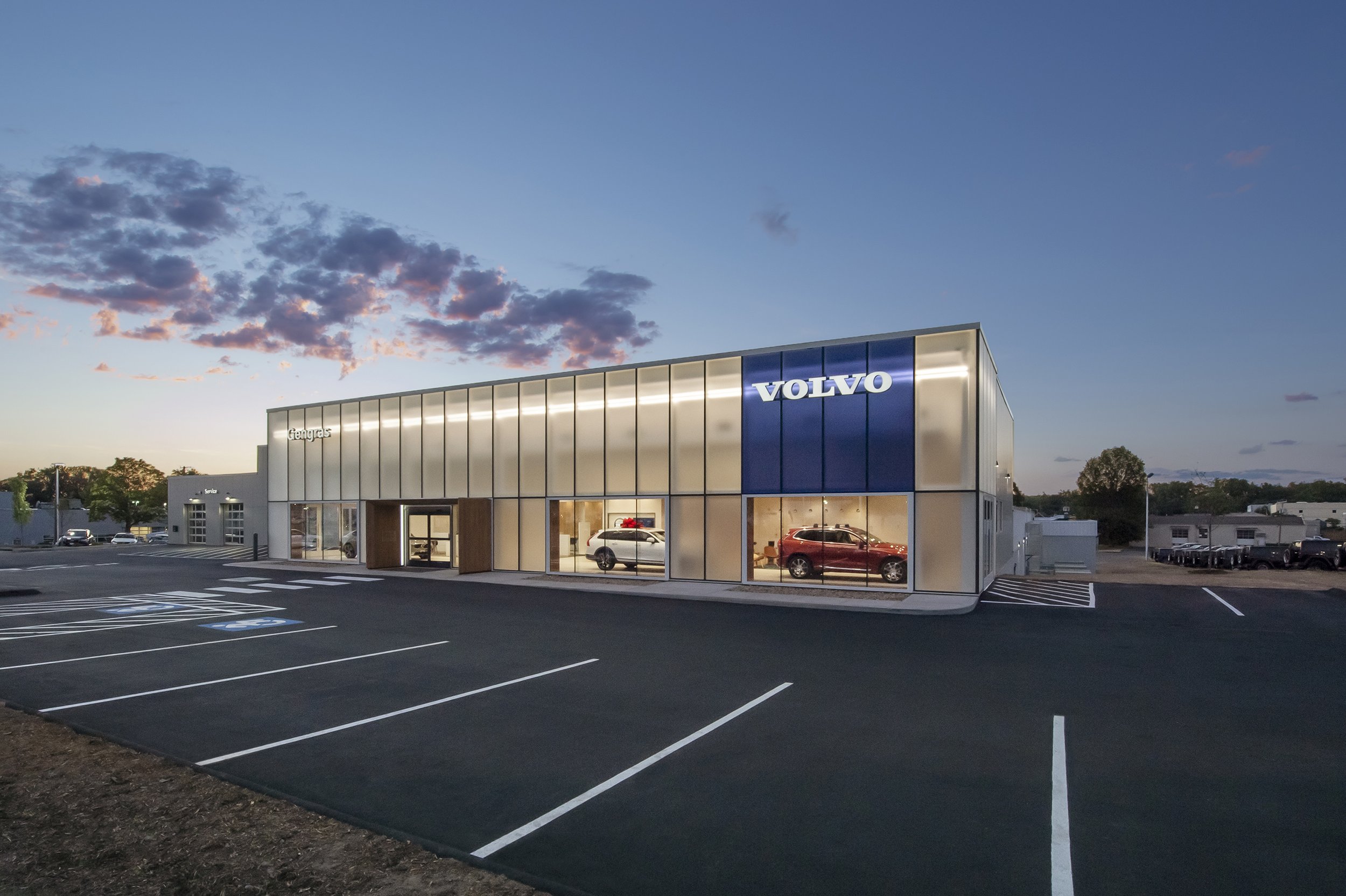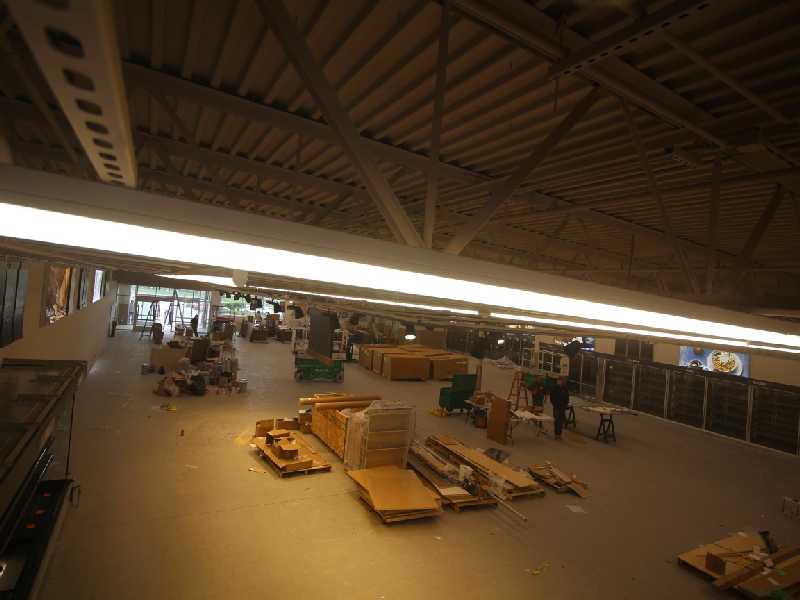Fortunato Construction Group was honored by the Greater New Britain Chamber of Commerce on Wednesday May 24, 2017 at Shuttle Meadow Country Club with the Developer of the Year Award for economic development in the town of Berlin. Fortunato Construction Group found it's home in Berlin, Connecticut 28 years ago, and has been a proud member of the community ever since. Congratulations to all of the Berlin businesses honored.
It's Safety Week 2017!
Leading Industry Collaboration
Hey, Valentine!
We think you're pretty great! We're wishing all of our FCG friends and family a happy Valentine's Day. We LOVE our relationship with you!
Are You Designing and Building with Wellness in Mind?
'The next wave' of design: Why wellness-minded spaces are on the rise
AUTHOR: Kim Slowey
PUBLISHED
Jan. 26, 2017
Via ConstructionDIVE
The push to make buildings more sustainable is nothing new, as the industry has largely embraced the growing trend. The U.S. Green Building Council's LEED (Leadership in Energy & Environmental Design) certification system is the most well-known name in the space, as there are more than 59,000 LEED-certified projects totaling 6 billion square feet in 164 countries.
For those up to a more rigorous, holistic endeavor, there is the International Living Future Institute's Living Building Challenge. Candidates navigate requirements such as the incorporation of biophilic components, the building site's impact on neighboring buildings and the environment and its ability to produce as much — or more — energy than it consumes. The cost-savings component of that program has struck a chord with private and public entities alike.
However, another trend related to sustainability is making waves in the industry: wellness. Although less definable than energy-efficient measures, wellness-minded design is growing in popularity as younger generations are pushing for healthier environments in their workplaces and homes.
From quantifiable to more ambiguous
There are several emerging sustainability measures and certifications, but what is the one thing they have in common? It's the fact that "sustainability is mathematically quantifiable," said Dave Hubka, director-commissioning for Transwestern's Sustainability Services group.
However, that isn't the case for the budding attention to occupant wellbeing.
Some wellness features in buildings are measurable, as evidenced by the International Well Building Institute's (IWBI) Well Building Standard certification. Some elements — like particulates in water or the kind of food being sold in the company breakroom — are measurable, but what constitutes one employee's bliss might be another's discomfort.
“I think that it is a kind of milieu we’re in driven by younger people who are much more sensitized to everything from environmental issues to sustainability to wellness and quality of life.”
"Wellness features, it's more difficult to quantify the effects on people," Hubka said. But that doesn't mean business owners, landlords and developers aren’t trying.
Indicating the popularity of the health and wellness philosophy, IWBI has found partners in the American Institute of Architects, the Cleveland Clinic, other sustainability certification programs like LEED and design giants like HKS — which are all trying to create healthy environments for occupants.
Millennials driving the trend
The ever-increasing popularity of healthy living has something to do with it, but that's nothing compared to the sea change that millennials have brought to the wellness table. "I think that it is a kind of milieu we're in, that we're probably going to stay in, driven by younger people who are much more sensitized to everything from environmental issues to sustainability to wellness and quality of life," said John Kirk, architect and partner at Cooper Robertson.
Offices are the biggest testing ground thus far, according to Hubka, with features designed to make workers happier, and therefore more productive. Food choices, high-quality lighting, water and air all serve to create healthier, energized surroundings, but employers are also adding those nebulous quality of life components like an open-desk, first-come-first-served policy called "free addressing," window seating, quiet rooms, days off to perform charity work, mindful eating areas and stress and addiction counseling.
All considered contributors to wellness — whether certified or not — many of these changes can only be quantified by looking at employee retention, Hubka noted.
Where wellness meets the home
As millennials and other demographics come to expect healthier workplaces, they're likely going to demand it in their living and other social environments as well. Kirk said that in the past, those in the market for custom high-end residences rarely thought twice about the impact of their building on their living environment, but that's starting to change.
"It seems like LEED and sustainability has become more mainstream. The next wave of what's to come is the people."-Dave Hubka, Director-commissioning for Transwestern's Sustainability Services group
Robert Thorne, CEO and co-founder of The Wellness Habitat Company, said many people have started to realize that while their wellness levels have been beefed up at work, diets have changed for the better and exercise routines have gone into high gear, they've been neglecting air quality, toxins, negative-impact lighting and other important health components in their own homes.
Through the state-of-the-art systems that can, for example, introduce and circulate probiotics in the air, diffuse homeopathic scents throughout the home at the push of a smartphone button, coax residents into a natural circadian rhythm and create stepped water purification systems, homeowners can create a space that connects the dots of their attempts at a healthier lifestyle, according to Thorne. "Your house now starts working for you," he said.
Wellness Habitat also serves the up-and-coming wellness needs of the hospital, hotel, office and multifamily industries. These features can help guests quickly overcome jet lag or help with hospital air quality. Of course, many occupants of high-rises or other residential developments are interested in being as healthy as possible as well.
As millennial-inspired ideas of work-life balance spread though the marketplace, that trend will alter corporate culture, particularly as millennials begin to take over in executive positions and ownership, according to Kirk.
"It seems like LEED and sustainability has become more mainstream," Hubka said. "The next wave of what's to come is the people."
Run, Run Reindeer!
This past weekend, while many of us were at home trimming our trees and decking the halls, some of our Fortunato Construction group family was out running for a cause.
Don Lenihan and Nick Chmura joined Deanna Scozzari in Westport, CT at the 2016 Jingle Bell Run for the Arthritis Foundation. Their team of 29 runners, Run Run Reindeer!, raised just under two thousand dollars at the festive event. Participants ran a 5k and spent the day celebrating the awareness and money they raised for the Arthritis Foundation - over thirty seven thousand dollars!
Fortunato Construction Group is proud to have sponsored Honoree Deanna and her commitment to helping others overcome some of the difficulties an arthritis diagnosis can present. We'd like to congratulate our runners Don (25:48) and Nick (25:58) for a race well run. Good work Reindeer!
Hot and Fresh: Savoy Pizzeria & Craft Bar
Fortunato Construction Group just completed work at the new premier pizzeria in West Hartford, Connecticut: Savoy. The newest addition to the Max Restaurant Group promises southern Italian cuisine, Neapolitan style pizza, and creative new craft cocktails. We can't wait to indulge!
Our Team is Growing!
Are you a project manger, estimator, field superintendent, or administrative assistant looking to join a great team? Fortunato Construction Group is looking for you!
Please visit our Careers page to learn more about the positions available and apply. We can't wait to hear from you!
““It’s a wonderful company to work for. It’s a great family environment. It’s a happy place to work, and I’ve learned a lot about the entire construction industry as a whole. It’s been great.””
Recently Completed: Saint Mary's Urgent Care and Primary Care Renovation
The project team of Rich Fortunato and Jon Gombotz recently completed a major renovation project at Saint Mary's Urgent Care and Primary Care facilities in Cheshire, Connecticut.
Here Comes Carter
This week, Fortunato Construction was awarded the construction of the new Carter Chevrolet Dealership in Vernon, Connecticut. This project will be a new ground up facility to house the relocated dealer.
This project is on a design build track, and includes a Butler building, and all other trades. Work will begin this month, with an expected completion in approximately one year.
This project will be managed by Bob Piazza. Steve Kravitz will develop the Butler design. Kyle Aivano will be the assistant project manager. Bill Roy will lead the project from the Field.
Fortunato Awarded Gengras Volvo Dealership
This week, Fortunato Construction was awarded the construction of a new Volvo Dealership for the Gengras Motorcar Company. The project is a design build collaboration to produce a new facility that meets the latest prototype requirements of Volvo.
FCG is not stranger to the Gengras Family. During the past 8 years, we have built or substantially renovated facilities for their Chrysler, Jeep, Dodge Franchise, their Fiat Dealership, and several other projects including their non automotive properties.
We're honored and excited to continue to grow this partnership, and to get started on the new Volvo Dealership!
Fortunato Construction at the Ballpark
On Friday, July 8th, Fortunato Construction Group enjoyed a fun night out at the New Britain Bee's Game, in two luxury suites at the New Britain Stadium. This summer outing has been an annual tradition at FCG for 19 years! This year brought great weather, lots of food, and a great pyrotechnic display.
CURE Innovation Commons featured in "The Day"
The coworking space and cafe is part of the new renovations at CURE Innovation Commons in Groton, seen on Thursday, June 23, 2016. (Dana Jensen/The Day)
Tech incubator opens in former Pfizer building with three tenants:
Learn more about this project here:
Watch Us Build
Fortunato Construction Group is currently building an Aldi Grocery Store in Plymouth, Massachusetts from the ground up. We've set up a camera on the job site to capture the activity on the site. The camera takes a photo, and our live feed updates every 10 minutes.
Check back often to see our progress, and watch what's happening live!
What About Brand
One of the buzzwords that has dominated the marketing and business development world in recent years is “Brand”.
What used to be a static concept as in “What brand are those jeans?” “They are Levi’s” was used primarily to identify the manufacturer often by a simple trademark or Logo.
But the marketing gurus have exposed the power of Branding. They have defined it in terms of communication and marketing channels that distinguish a brand from its competitors and creates a durable impression on its customers.
Included among the key aspects of a brand in addition to identity, are communication, awareness, loyalty and culture. These are all unified by a particular method of conducting business and treating customers.
A company’s brand is its promise to its customers that they can expect consistent delivery of a particular outcome. The results often include intangibles such as customer satisfaction and brand loyalty.
Does it work?
Here’s a personal anecdote that suggests it is even more powerful than we realize.
I recently found an old pair of Nikon binoculars. Although purchased in 1986, they were in perfect condition, but missing an eyecup. I thought finding a replacement eyecup would be easy on the internet. Nikon could not identify the product based on the model name or serial number. They advised me to send them the binoculars.
Two weeks later I received a replacement pair without question or cost. Nikon's binocular warranty is a no fault repair or replace policy. Pretty simple. Building brand loyalty one customer at a time is as relevant in Construction as it is on consumer products or any industry.
I’m shopping for a new camera before my next vacation. Any guess as to which brand will prevail?
Four in Four
TM Crowley on behalf of CVS has retained Fortunato Construction Group for the constrution of their new store in Monroe, CT.
Bob Piazza prepared the bid and will manage the project with Tom Marra as the superintendent.
This is the fourth CVS project FCG is building in as many years.
Are you a subcontractor interested in bidding on opportunities like this one? Visit our subcontractor portal to connect with us.
Goodbye Delays, Hello Permits
One architect's new permit streamlining process could provide benefits for all
By Tim Culvahouse, FAIA
For over a decade, architect Michael F. Malinowski, AIA, has organized annual “Code Conversations” hosted by California's AIA Central Valley. These gatherings bring together building officials and design professionals from across the Sacramento area for informal dialogue. Harnessing the culture of cooperation they have generated, Malinowski—current president of the AIA California Council and a member of the AIA Codes and Standards Committee—recently led the development of a permit streamlining process known as the Prequalified Architectural Submittal System (PASS).
The Wall Street Journal recently addressed the adverse economic impact that extended delays in building permits approvals is having on the U.S. housing market. And the core principle of PASS is that high-quality permit documents should accelerate approvals. This approach distinguishes it from self-certification programs, which allow approved design professionals to bypass plan review by certifying a project as code compliant. While some jurisdictions have had decades of positive experience with self-certification, many building officials remain skeptical of a process that postpones approval to field inspection. As Steve Burger, the chief building official of Folsom, California, asks, “When do you want us to catch problems, on paper or in the field?”
The Prequalified Architectural Submittal System, a process led by Michael F. Malinowski, AIA, could redefine how high-quality permit documents are approved.
Unlike self-certification programs, PASS facilitates permitting without reassigning responsibilities or changing the approval path. Instead, it clarifies, in a Building Project Submittal Checklist, the information required in a submittal. Participants in the program—both authors of permit documents and lead plan reviewers—must pass a training course on effective ways of satisfying the checklist.
“PASS starts with just a list,” says West Sacramento building official Randall Goodwin, “but the brilliance of it is the collaboration. The traditional view is it’s an antagonistic relationship, but this puts us all on one team.”
Formalizing the Code
For PASS, that team is a steering committee comprised of architects, economic development experts, and plan review professionals from seven jurisdictions. Over a six-month period, beginning in January 2015, the group came to consensus on a 127-item checklist covering both code analysis—the process of determining what code provisions apply to a particular project—and code compliance. It is, as Burger says, “a formalization of what we have been trying to do for years, in terms of saying what we need to see.”
To develop training materials, Malinowski asked plan reviewers from five jurisdictions to use the checklist to grade three anonymized sets of plans donated by area architecture firms. Reviewer consensus determined the examples to be used in the course. These examples aren’t prescriptive; among them, Malinowski notes, is “an incredible variety of how architects portrayed information, where it was portrayed, and how the set was organized.”
The first PASS training course was held in July 2015; as of the beginning of March 2016, nearly 100 design professionals and plan review professionals have become registered PASS participants. The program is open to all those who are allowed by law to be responsible for plan submittal—architects, engineers, and, for some project types, interior designers and contractors. Eleven Sacramento area municipalities and three counties—collectively home to 2.5 million people—have adopted PASS without modification, a boon to architects working across jurisdictions.
Documents that follow the PASS guidelines—providing information thoroughly and transparently—make it easier for plan reviewers to assess compliance. This ease speeds the process, as does the provision that documents signed by a registered PASS professional are accepted without intake review. Not only does this provision reduce the number of rounds of review, it also means that anyone, even a courier, may deliver plans to the building department.
Impact Already Felt
The number of PASS submittals is not yet great enough for statistical analysis, but plan reviewers report evident improvements in quality and fewer rounds of review, from the typical three down to two or even one. An ongoing quality-assurance process maintains consistent compliance. Plan reviewers flag PASS-certified sets that aren’t PASS-compliant and refer them to the steering committee, which after validating the flag alerts the submitter. A participant who receives three flags in a year loses certification and must retake the training class and exam. So far, no flags have been reported.
In addition to streamlining the process, the PASS program is a useful tool for training young people on both sides of the counter. For entry-level permit technicians as well as architectural interns, the checklist promotes both a thorough attention to detail and an understanding of the big picture—the full scope of health, safety, and welfare considerations.
The PASS program is proving to be of value in several ways: It speeds approvals, both during permit issuance and during construction, providing real financial benefits to all parties—building department, architect, and developer. It helps educate young professionals. And it is building a spirit of collaboration between designers and regulators.
Along with the Code Conversations that led to it, PASS is an encouraging example of architects engaging in the formation of public policy. As Malinowski points out, “Architects have a vested interest in being leaders of the process from the beginning to the end. Between design and construction comes permitting, and we should be at that table.”
Tim Culvahouse, FAIA, is a professional development consultant for architecture and related disciplines.


























